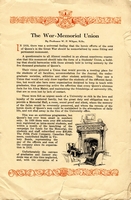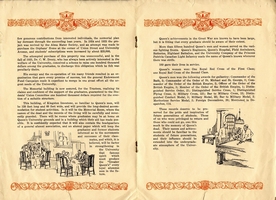Index
- World War 1
- Campus Memorials
- Queen's Units
- WWI: Lives Lost (Story Map Part I, Part II)
Introduction
"Today, we ask a new generation of Canadians to surrender their time, volunteer their hearts, and take one year to fully remember a century of sacrifice. That year is 2005 - The Year of the Veteran."
- Minister of Veteran's Affairs, The Honourable Albina Guarnieri
This project was undertaken, through generous support from the John Deutsch University Centre, in order to commemorate the lives of those Queen's students who died in defense of their country. Every year it is important to honour veterans and their service, which is why, in addition to this virtual exhibit, Queen's University will maintain a permanent memorial in the John Deutsch University Centre in order to ensure the remembrance of these individuals for many years to come.
Please note: Material in this exhibit is provided for personal and private research use only. Publication of any material requires permission of Queen's University Archives - contact archives@queensu.ca for more information.
Acknowledgements
Queen's University Archives would like to thank and acknowledge Bob Burge of the John Deutsch University Centre and the Office of Advancement for their financial contributions; Dr. Gordon Dueck for his hours of work on this project; Dr. Kathryn Bindon for her kind permission to excerpt liberally from her work; and Blake Seward of the Lest We Forget Project for the inspiration.
Queen's Remembers: The First World War
- Campus Memorials
- Queen's Units
- WWI: Lives Lost (Story Map Part I, Part II)
Campus Memorials
The War-Memorial Union
By Professor W.P. Wilgar, B.Sc. [ca. 1926]
In 1919, there was a universal feeling that the heroic efforts of the sons of Queen’s in the Great War should be memorialized by some fitting and permanent monument.
A questionnaire to all Alumni resulted in an almost unanimous expression that this monument should take the form of a Students’ Union, a building that should harmonize with those already held in loving memory by the five thousand graduates of Queen’s.
Their vision pictured a Union that would provide a meeting place for the students of all faculties, accommodation for the Journal, the under-graduate societies, athletics and other student activities. They saw a Union that would not only draw together the students of the different faculties, but would also have some organization designed to keep in touch with graduates, thus preserving active the affection that every Queen’s alumnus feels for his Alma Mater, and maintaining the friendships of university life, that are so soon lost by lack of contact.
These were felt as urgent needs of a University so rich in the love and loyalty of its scattered family, but the great duty and obligation was to provide a Memorial Hall, a room, sound proof and silent, were the memory of the fallen would be reverently preserved, and where the records of heroic deeds of Queen’s men could be maintained in the atmosphere of daily life, and not shut away in the files of the University office.
This was an ambitious programme, but Queen’s has ever been small in numbers only. In 1920 there were over 400 returned men registered as intra-mural students, and within a month of the launching of the campaign for funds for the Memorial, the students and staff subscribed over $30,000. The Fifth Field Company, Canadian Engineers, contributed $4,000 in Victory Bonds, representing the pay of the officers and men of the company since its organization in 1910.
Unfortunately the canvas of graduates and former students was at this time neglected, and, with the exception of a few generous contributions from interested individuals, the memorial plan lay dormant through the succeeding lean years. In 1924 and 1925 the project was revived by the Alma Mater Society, and an attempt was made to purchase the Orphans’ Home at the corner of Union Street and University Avenue, and students’ subscriptions were increased by about $25,000.
The attempted purchase of this property was unsuccessful, and in the fall of 1925, Dr. C.W. Drury, who has always been actively interested in the welfare of the University, conceived a scheme to raise one hundred thousand dollars among the graduates, to discharge this obligation which he felt was peculiarly theirs.
His energy and the co-operation of his many friends resulted in an organization that gave every promise of success, but the general Endowment Fund Campaign made it expedient to merge in one great effort all the urgent needs of the University.
The Memorial building is now assured, for the Trustees, realizing its claims and confident of the support of the graduates, guaranteed to the Students’ Union Committee one hundred thousand dollars required for the erection of a suitable structure.
This building, of Kingston limestone, so familiar to Queen’s men, will be 120 feet long and 60 feet wide, and will provide the long-desired accommodation for student activities. In it will be the Memorial Room, where the names of the dead and the records of the living will be carefully and reverently guarded. There will be rooms where graduates may be at home on Queen’s University grounds and in a building which their aid has made possible. It is confidently expected that it will also contain the headquarters of a general alumni association, and an alumni paper which will keep the graduates and former students informed as to the movements and successes of their classmates, and which, it is believed, will be factor in strengthening in the University that famous spirit which much produce the “Greater Queen’s” every loyal alumnus sees in the future.
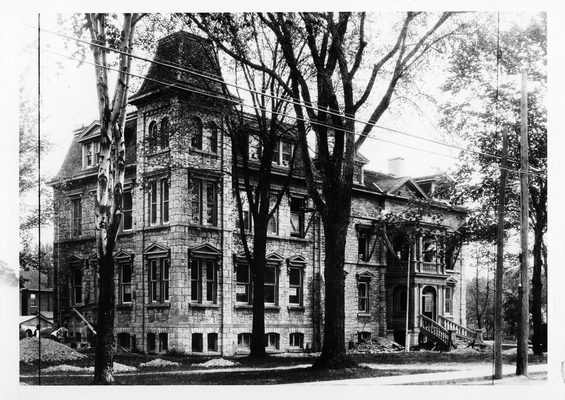
Queen’s achievements in the Great War are known to have been large, but it is fitting that every graduate should be aware of their extent.
More than fifteen hundred Queen’s men and women served on the various fighting fronts. Queen’s Engineers, Queen’s Hospital, Field Ambulance, Batteries, Highland Battalion, and the University Company of the Princess Patricia Canadian Light Infantry made the name of Queen’s known wherever there was strife.
189 gave their lives in service.
Queen’s women won: One Royal Red Cross of the First Class; one Royal Red Cross of the Second Class.
Queen’s men won the following awards for gallantry: Commander of the Bath, 2; Commander of the Order of St. Michael and St. George, 8; Commander of the Order of the British Empire, 2; Officer of the Order of the British Empire, 3; Member of the Order of the British Empire, 1; Distinguished Service Order, 21; Distinguished Service Cross, 1; Distinguished Flying Cross, 3; Military Cross, 121; Bar to Military Cross, 12; Distinguished Conduct Medal, 8; Military Medal, 22; Bar to Military Medal, 2; Meritorious Service Medal, 2; Foreign Decorations, 20; Mentioned in Despatches, 114.
These records deserve to be preserved for the pride and inspiration of future generations of students. Those of us who were privileged to return and those who could not go, owe this much to the memory of Queen’s dead. Their names and achievements should be familiar to the students of future generations, and their influence should be extended into the undergraduate atmosphere of the University.
George Richardson Stadium
"By the great kindness of Mr. James Richardson, a graduate of the University, a new stadium is being built on the Union Street athletic ground in memory of Captain George T. Richardson, whose fame as a man and an athlete is becoming one of the great traditions of the University. The Stadium will consist of a foot-ball ground with a running track, a grandstand to accommodate 1900, and dressing room accommodation for foot-ball teams and for the women's hockey team; the bleachers will seat about 1500." Queen's University Annual Report 1919-1920, Principal's Report, p.10
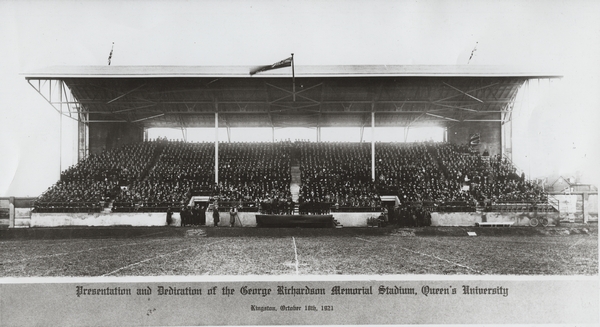
"Most of the Trustees have already seen the splendid stadium which has been erected by Mr. James Richardson in memory of his brother, Captain George T. Richardson. Nothing more fitting could have been done to cherish the name of a man who stood for all that was best and most honourable in sport. Not only is the gift a noble one in itself, but it will enshrine for generations of students the name of one who was greatly loved, and it may be trusted to do something to perpetuate his type. No one who was present on the opening day will ever forget the ceremony by which the stadium was dedicated or the subsequent game in which, after years of striving, the 'Varsity team was decisively beaten by Queen's. It was taken, as indeed it proved to be, as an augury of good things in the realm of sport." Queen's University Annual Report 1921-1922, Principal's Report, p.2
Queen's Military Units - World War One
Fifth Field Company Engineers
The Fifth Field Company Canadian Engineers spent the years preceding the war becoming a well-qualified military unit. By 1914, total enrolment in the Fifth was 160 men. The activities of the Company included not only rifle and infantry drill, but also signals training and bridge and fortification construction. With the start of World War One… the training of the Fifth during the previous four years permitted a quick response to the national emergency… The first need created by the war, a camp for Canadian soldiers who were to be sent overseas, demanded a very real response from Queen’s.

The Fifth Field Company was given the task of turning previously unimproved ground at Valcartier, Quebec, into a camp capable of mobilizing 30,000 men. ..only ten days after the initial inquiry, mobilization orders were telegraphed to all members of the Company and the majority of the men left Kingston for Valcartier on August 18, 1914. In all 170 Queen’s men worked at Valcartier on a variety of jobs that included road repair, surveys for tent sites, and installation of a water supply system.
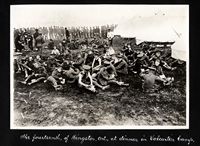
The experience of setting up the camp at Valcartier was an invaluable one for the Fifth Field Company. More than that, however, it firmly established the fact that ‘the only purely University Company in Canada’ was an important asset to the nation’s armed forces. Queen’s ‘alone among Canadian Universities… had done immediate, practical work’ during the first phase of mobilization.
When other Companies of Engineers arrived at Valcartier, the Fifth was split into overseas and home sections… fifty members of the Queen’s Company signed up to be sent abroad with the First Canadian Contingent for service with No. 2 Company of Engineers. The home service of the Fifth Field Company remained at Valcartier until October 1914, when members returned to Kingston and began recruiting for the second overseas contingent.
6th Field Company Engineers
In January 1915, 110 men left Queen’s to join the Second Contingent, Canadian Expeditionary Force as officers, sappers, drivers, or mechanics. These volunteers formed half of the 6th Company Engineers. Along with others from Ottawa and Montreal, the Kingston recruits made up the nucleus of the three field corps of engineers that formed the 2nd Canadian Expeditionary Force. All of the men trained in Ottawa before being sent overseas in the spring of 1915.
All of the Queen’s men serving in this Company maintained an awareness of their university affiliation throughout the period in their active enlistment. Although the special cohesion and camaraderie evident during the early days in training camp, when queen’s men competes as a group in athletic events and gathered together for social evenings, was gradually changed by the experiences of war into more of a general company spirit, there remained a strong bond between the original Kingston members of the Company.
Canadian Universities' Unit
Many Queen’s cadets joined with volunteers from other universities to form various university companies that were a part of the Canadian forces during the First World War. The Canadian Universities’ Unit (CUU) became a part of the 38th Battalion, which in 1915 was with the Third Contingent of the Canadian Expeditionary Force. Sixty of the members of the CUU were Queen’s students.
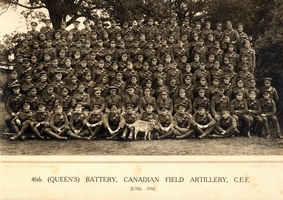
46th (Queen's) Battery
The 46th [Battery] under the command of Professor L. W. Gill of the Department of Electrical Engineering was almost completely drawn from amongst members of the university. The sixty members of this battery moved into barracks in November of 1915, and by early 1916 were on their way to England for further training. Eventually the 46th was sent to France where they acquitted themselves with distinction in the Battle of the Somme.
50th (Queen's) Battery
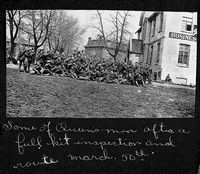
The nucleus of the 50th (Queen’s) Battery was formed by the members of the 46th who did not go overseas. Commanded by Captain G. D. Anglin, the unit was up to strength by the spring of 1916 and was sent to England where it was split up to reinforce other batteries.
72nd (Queen’s) Battery
The third battery, the 72nd, was recruited during the academic session of 1916-1917 and by the spring of 1917 was preparing to send a draft of 150 men and three officers to England.
253rd Battalion (Queen's University Highlanders)
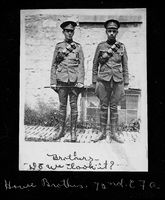
The 253rd Queen’s University Highlanders was destined to become a reinforcement unit. Sir Andrew Macphail in his “History of the Canadian Forces 1914-1918” asserted that the ‘253rd Battalion… had little connection with Queen’s except for its name, drawing its personnel from the general public’, the unit owed more than just its name to the university. The problems of recruitment faced by the Battalion Commander, Lt.-Col. P. G. C. Campbell, were great since many students had already volunteered for active service overseas. Because that session’s COTC was unable to provide many men for the 253rd, for example, its members donated $500 of their pay and allowances to the new unit to help its formation. In March the [Queen’s] Journal made a final successful appeal for men and by May the 253rd was in England, where it was broken up and absorbed into various reserve battalions.
No. 5 Stationary Hospital / No. 7 (Queen's) Canadian General Hospital

[The No. 5 Stationary Hospital] was open to students and graduates of all faculties at Queen’s, and volunteers for the project were many. The staff of the hospital consisted of ten men – eight medical officers, a Dental Surgeon and a Quarter-Master. Six of these officers were members of Queen’s Faculty of Medicine. The total establishment for the 200 bed hospital, ninety-four men and thirty-five nursing sisters, was recruited in just over two weeks. The Kingston men [and women] boarded ship in Montreal on May 6 [1915] and ten days later debarked at Plymouth Harbour. …the unit’s first assignment was the establishment of a 400 bed hospital at St. Martin’s Plain in England.
On July 24 new orders were received, and the unit prepared to establish a 400 bed hospital at Cairo for men on Eastern Overseas Service. Forty-five reinforcements arrived from Kingston, and the group was transported to their new location. In January 1916, the unit was reclassified and became No. 7 Canadian General Hospital with an establishment of 1,040 beds.
The end of the Gallipoli campaign resulted in a decreased demand for medical services on the eastern front. Thus, on April 10, 1916, having treated some 10,000 patients in the Cairo hospital, the members of the unit once again boarded ship… to their final destination,… Etaples, France. The task this time was to set up a tent hospital.
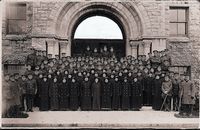
The arrival of winter soon convinced the Hospital Corps of the impossibility of running a tent hospital, and while their patients were transferring to other hospitals in the area, No. 7 General Hospital prepared to move to a more permanent site. In November 1916, [the]… Hospital was moved to a site consisting of thirty-five wooden huts. Due to the ‘steady succession of engagements carried out in the British offensive’ of that period, the pressure of work was constant and the hospital, originally 1,040 beds, comprised 2,290 in March 1917. It was maintained at that level for the rest of the war.

The Queen’s hospital was in all respects a success. In Cairo, between August 26, 1915 and March 23, 1916, 4,140 patients were admitted, of whom only 28 died. In France between November 15, 1916 and August 31, 1917, No. 7 General Hospital treated 35,783 people, with a total of only 386 deaths. The students involved gained a vast amount of valuable practical experience, as well as being able to continue academic courses of study under some of the professors who were with the hospital.
All material in the Queen's Units section is excerpted from Kathryn Bindon's book Queen's Men, Canada's Men: The Military History of Queen's University, Kingston, 1978.
World War One: Individuals who lost their lives
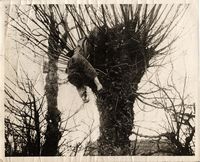
Each of these individual files were kept by the War Record Committee of Queen's University. They contain information regarding those staff, students, alumni and faculty who died in service during the First World War. The files may include correspondence with parents and relatives regarding the individual, correspondence concerning the gathering of this information, military service cards and rolls, newspaper clippings, indices, and photographs. The amount of material for each person varies from file to file.
These records are also available at the Queen's Remembers: The First World War Story Map Part 1 and Queen's Remembers: The First World War Story Map Part 2, each accompanied by the locations of individual grave sites.
Queen's Remembers: The Second World War

- The University's Response
- COTC at Queen's
- Women and the War
- War Aid Commission
- Principal's Report 1940-41
- Principal's Report 1943-44
- WWII: Lives lost
The University's Response
The University's approach to the events of 1939 was generally cautious - not only because of the confusion that existed about the nature of the national commitment, but also because all were convinced that the war would be a long and costly one. "Now Canada is at war." said Wallace, "The temper of the nation shows that it is not likely to be a short or easy struggle; rather it will, in all probability, be grim and prolonged." Unlike 1914, young men in 1939 were well aware of the exigencies of war, and their response was of necessity much different. The editorial by Peter Macdonnell in the November 7th, 1939 Queen's Journal was reflective of the general mood of the student body when it stated:
"This time it is different. When people go to war this time they have some idea what they are going to; they expect not romance and high adventure but discomfort, drab weariness, suffering, death. Nor are they very sure that the world will become Utopia even when the war is won. They only feel sure that the war must be won if the things we value are to be preserved, though they sometimes fear that a second great war may wreck our civilization whoever are the victors. … Those who are giving up long-cherished plans and are preparing to do their bit in this struggle are showing the highest kind of courage, the kind that recognizes all the dangers it is going to meet and yet resolves to meet them, with little enthusiasm and no heroics it is true, but with steadfastness and determination."
Canadian Officers' Training Corps at Queen's

The COTC was an important influence in the life of many Queen's students. The announcement just before registration in 1939 that COTC training would count as an academic credit precipitated a sizeable influx of students into the Contingent. Unfortunately, while over 800 students enrolled, permission had not been granted beforehand for an increase from the former establishment of 246 cadets. Numerous letters were sent to Ottawa requesting permission for all 815 cadets to be allowed to write the qualifying examination and thereby obtain the academic credit. After some delay, permission to increase the size of the Contingent was granted by the Chief of the General Staff, with the stipulation that those accepted in excess of the original enrolment not be paid. Enlistment, which peaked at 842 in November 1939, finally levelled off at 648 for the session. Notwithstanding shortages of equipment, uniforms, and instructional materials, students enthusiastically enrolled for military training in five major areas: Artillery (201), Engineering (224), Signals (20), Infantry (144) and Field Medicine (33).
Women and the War
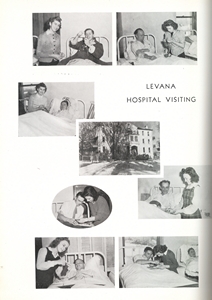
Dean Douglas addressed women students early in the term [1940] in an effort to focus their participation in the Queen's war effort. 'Women are not called upon to drill,' she began 'but they should do their part.' Once again, stenography, first aid, and home nursing were mentioned, and a Red Cross Room was proposed for Kingston Hall where female students could knit and roll bandages together. In concluding her remarks, Dr. Douglas "urged every girl to realize her responsibilities in disciplining mind and will. In so doing she may help rebuild the future."

The Queen's detachment of the Women's Voluntary Service Corps was formed in early 1941 with an enlistment of about 30 women, [its] future was ensured in September 1941 when Dean Douglas outlined in fairly forceful tones the available work for women, and the Senate decided that a minimal amount of female participation in the war effort would be mandatory. First year women were required to enroll in the St. John's Ambulance first-aid course, while Upper-year women who hoped eventually to enlist in the Women's Auxiliary Army or Air Force Corps were urged to enter the Women's Corps; others were encouraged to do hospital visiting and Red Cross work.
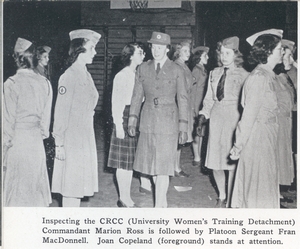
Direct involvement of Queen's women in military-related activities during the 1941-42 session was on the whole a success, with enrolment a respectable 124 in first aid and 60 in the training detachment. With most co-eds participating in Red Cross work and hospital visiting as well, Dean Douglas' comment that "there…[is] no question of the world's need of women's services, particularly in wartime", was to prove more and more correct as the conflict wore on.
Queen's War Aid Commission
Queen's War Aid Commission (QWAC) was the fund raising body of the students on campus. The first fund raising scheme went into effect before the end of the winter term of the 1940-41 session: War Aid Stamps, to be affixed to all mail, were placed on sale on December 6, 1940. At a cost of only one cent, no argument of financial stringency could excuse the participation of any student in this particular plan. The stamp campaign had a dual benefit, as well: while stamp sales raised money for the war effort, their use was evidence to the rest of the community of the University's active involvement. Yet another campaign involved the collection of old magazines and books for redistribution to military personnel based at Barriefield.
In January 1941, the QWAC set students a definite objective in the hope that this would increase their efforts to gather funds. In addition to their donations to the Red Cross, The War Aid Commission decided to purchase a field ambulance worth $1400. Although the AMS had "previously decided that an ambulance was too high an objective for Queen's and that the QWAC had 'put the AMS on the spot' by adopting it as an objective," the Journal staff enthusiastically endorsed the plan and called for a real effort to give "all-out aid". To ensure success, the AMS endorsed a personal subscription campaign involving the distribution of special "Ambulance Drive" envelopes to each student. The response was such that by March 7, 1941, the treasurer reported a total of $1,443.48 in the Ambulance Fund, an accomplishment that represented one of the major fund-raising successes of the QWAC.
The Repercussions of the War - Principal's Report 1940-41
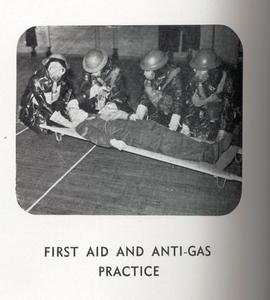
After consultation with the Departments of National Defence and of War Services, the universities of Canada established compulsory military training for all students of eighteen years or over, who are of British citizenship. At Queen's, as at December 31st, 1252 men were taking training, 849 in the C.O.T.C. and 403 in the auxiliary battalion. Six hours per week have been taken up in drill and lectures, and in the case of the C.O.T.C. the time has on occasion been considerably greater. The women students have been engaged in Red Cross work, and in first aid and women's auxiliary service training. The War Aid Commission has had various devices for raising funds for a fully equipped ambulance - public lectures by prominent Canadians, novelty booths and sale of corsages at dances, and other ingenious methods of extracting funds from a not-too-affluent clientele.
The intercollegiate sports programme has been discontinued, and interfaculty sports, which are much less time-consuming, have been fostered in order to maintain the values which come from active participation in a healthy sports programme. Some of the glamour and excitement which accompanies the rivalry of the universities on the football field has been missing; but the time of students has been so heavily taken up in military activity that it would have been very difficult, had it been advisable, to carry on effectively in inter-university meets this year.
Under the strenuous conditions which they have had to face, the temper of the student body merits high praise. This has not been an easy year. Afternoons or evenings have been taken up in military or other war work. There has been little time for the organizations which form an important part of student life and education. Yet they have continued to function, even if in more limited sphere of activity. Practically to a man, the men students of eighteen years and over have fulfilled their military requirements, which have been rigidly administered in accordance with the understanding with the Government. The high quality of the courses of instruction given under the direction of Col. Earl as officer commanding, with Col. Jemmett as officer in charge of instruction, has made the administration of the compulsory training plan an easy task. No student at Queen's has refused to take the training, and, with only two or three exceptions, the students of eighteen years of age and over have completed the 100 hours of instruction laid down in the syllabus.
The call on members of the staff has been heavy and insistent. Sixteen faculty members have obtained leave to give their time to military service or war work. Several others have been partially relieved from their duties, to give part time to war work, while very many are giving all their spare time to war work, while very many are giving all their spare time to one form or other of national service. Special courses have been established. In electrical engineering and physics, a senior year group has been trained specially in communication and radio direction finding for the needs of the services, and a special course on radio direction finding will be given at the request of the Government during the summer months. Members of the Medical Faculty have given courses for medical officers of the units in the district on medical and surgical problems related to the war. The extramural service of Queen's University has been made available to officers and men in the Active Service Forces whether in Canada or overseas, in order that, when time is available, they may continue the studies which have been interrupted on enlisting for service. In several laboratories special research is being carried on, some of which is of a highly confidential nature, to meet the problems which the war has created. The call for members of staff and for students is becoming more urgent as the war needs grow more pressing. There is little doubt that the University will face next year grave difficulties, which will make our present problems seem insignificant. They will be part of the sacrifice we should pay - and pay gladly - in the cause for which the people of Britain are displaying a heroism and an endurance to which no tribute of words can do adequate justice.
War Work - Principal's Report 1943-44
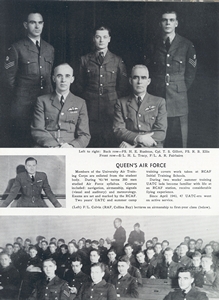
The war goes on, and with increasing intensity. There are inevitable repercussions to the university. Fewer and fewer men are going on to senior years in arts, and those who do go on are in the main in the lower physical categories, unless they are specializing in the sciences. The total attendance is over three hundred below our maximum registration, and the decrease is mainly in the registration of arts men. All physically fit men students take training under the Canadian Officers' Training Corps, the University Air Training Corps, or the University Naval Training Division. A continuous stream of young men pass through our halls under the Royal Canadian Air Force. They are given a six weeks' course in mathematics and physics under their own officers in our lecture rooms and laboratories. They are quartered in the gymnasium. Last autumn 135 men were admitted who had been specially selected by Army authorities to take a year's training in scientific subjects. They have enlisted in the Army, and are in uniform and under Army pay. Seventy-two have senior matriculation standing, and are taking the regular work of the first year in applied science. Sixty-three have junior matriculation standing, and are in first year arts in a curriculum made up mainly of science subjects. After five weeks of additional training in subjects of special military significance these men will be absorbed into technical branches of the Army. They are quartered in the basement of Kingston Hall and have their meals, as have the R.C.A.F. men, in the basement of Grant Hall.
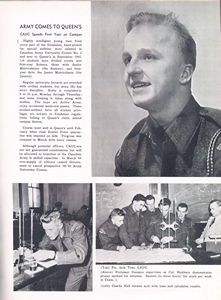
The University Training Detachment, Canadian Red Cross Corps receives training which fits women to enter any one of the three women's services. They are given basic drill and instruction from others in the Navy, Army and Air Force. They take their training in Grant Hall. An increasing number of our women graduates and undergraduates are selecting the women's services, and the training in the C.R.C.C. is helpful in making the decision. During the first term as well all the women students have taken a course in nutrition and health; and in the second term the first year students have taken the St. John Ambulance Association course in home nursing. Every undergraduate women registers for voluntary work in one or other of a variety of activities - Red Cross work, hospital visiting, Girl Guide leadership, business training, serving in soldiers' canteens, and the like - for at least two hours per week. The women of the university are doing a fine service in war work.
Research work in war problems is carried on in ever increasing amount. As it is practically entirely secret work, no statement can be made about it, other than that some of the work has proved to be of great value. The work is financed by the Dominion Government, in the main through the National Research Council. Very material financial assistance comes to Queen's University in this way.

There is a sense of strain, and of overwork. But that is not peculiar to universities. No one is living a normal well poised life in these times. Until the war is over, until victory is won, and until the problems that must be met at the close of the war are on the way to a reasonable solution, we shall all work under a load. As compared with the responsibilities that are carried by business men under the stress of war, our load is light. It is our responsibility to endeavour to see farther into the future, and to strive, through education and training, to prepare young men and women - and older men and women too - for the task that lied ahead.
World War II: Individuals who served or lost their lives
Each of these individual files were kept by the War Record Committee of Queen's University. They contain information regarding those staff, students, alumni and faculty who died in service during the Second World War. The files generally include military service cards and rolls, obituaries and photographs, although some files may also include clippings from the Queen's Review or other sources.
